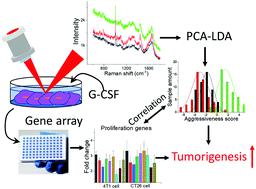Our official English website, www.x-mol.net, welcomes your feedback! (Note: you will need to create a separate account there.)
Granulocyte colony-stimulating factor promotes an aggressive phenotype of colon and breast cancer cells with biochemical changes investigated by single-cell Raman microspectroscopy and machine learning analysis
Analyst ( IF 4.2 ) Pub Date : 2021-09-20 , DOI: 10.1039/d1an00938a Wei Zhang 1 , Ioannis Karagiannidis 2 , Eliane De Santana Van Vliet 2 , Ruoxin Yao 2 , Ellen J Beswick 2 , Anhong Zhou 1
Analyst ( IF 4.2 ) Pub Date : 2021-09-20 , DOI: 10.1039/d1an00938a Wei Zhang 1 , Ioannis Karagiannidis 2 , Eliane De Santana Van Vliet 2 , Ruoxin Yao 2 , Ellen J Beswick 2 , Anhong Zhou 1
Affiliation

|
Granulocyte colony-stimulating factor (G-CSF) is produced at high levels in several cancers and is directly linked with metastasis in gastrointestinal (GI) cancers. In order to further understand the alteration of molecular compositions and biochemical features triggered by G-CSF treatment at molecular and cell levels, we sought to investigate the long term treatment of G-CSF on colon and breast cancer cells measured by label-free, non-invasive single-cell Raman microspectroscopy. Raman spectrum captures the molecule-specific spectral signatures (“fingerprints”) of different biomolecules presented on cells. In this work, mouse breast cancer line 4T1 and mouse colon cancer line CT26 were treated with G-CSF for 7 weeks and subsequently analyzed by machine learning based Raman spectroscopy and gene/cytokine expression. The principal component analysis (PCA) identified the Raman bands that most significantly changed between the control and G-CSF treated cells. Notably, here we proposed the concept of aggressiveness score, which can be derived from the posterior probability of linear discriminant analysis (LDA), for quantitative spectral analysis of tumorigenic cells. The aggressiveness score was effectively applied to analyze and differentiate the overall cell biochemical changes of G-CSF-treated two model cancer cells. All these tumorigenic progressions suggested by Raman analysis were confirmed by pro-tumorigenic cytokine and gene analysis. A high correlation between gene expression data and Raman spectra highlights that the machine learning based non-invasive Raman spectroscopy offers emerging and powerful tools to better understand the regulation mechanism of cytokines in the tumor microenvironment that could lead to the discovery of new targets for cancer therapy.
中文翻译:

粒细胞集落刺激因子促进结肠和乳腺癌细胞的侵袭性表型,通过单细胞拉曼显微光谱和机器学习分析研究生化变化
粒细胞集落刺激因子 (G-CSF) 在几种癌症中高水平产生,并与胃肠道 (GI) 癌症的转移直接相关。为了进一步了解 G-CSF 治疗在分子和细胞水平上引发的分子组成和生化特征的改变,我们试图研究 G-CSF 对结肠和乳腺癌细胞的长期治疗,通过无标记、非-侵入性单细胞拉曼显微光谱。拉曼光谱捕获细胞上呈现的不同生物分子的分子特异性光谱特征(“指纹”)。在这项工作中,小鼠乳腺癌细胞系 4T1 和小鼠结肠癌细胞系 CT26 用 G-CSF 治疗 7 周,随后通过基于机器学习的拉曼光谱和基因/细胞因子表达进行分析。主成分分析 (PCA) 确定了在对照和 G-CSF 处理的细胞之间变化最显着的拉曼条带。值得注意的是,在这里我们提出了侵袭性评分的概念,它可以从线性判别分析 (LDA) 的后验概率推导出来,用于致瘤细胞的定量光谱分析。侵袭性评分有效地应用于分析和区分 G-CSF 处理的两种模型癌细胞的整体细胞生化变化。拉曼分析表明的所有这些致瘤进展都通过促致肿瘤细胞因子和基因分析得到证实。
更新日期:2021-09-21
中文翻译:

粒细胞集落刺激因子促进结肠和乳腺癌细胞的侵袭性表型,通过单细胞拉曼显微光谱和机器学习分析研究生化变化
粒细胞集落刺激因子 (G-CSF) 在几种癌症中高水平产生,并与胃肠道 (GI) 癌症的转移直接相关。为了进一步了解 G-CSF 治疗在分子和细胞水平上引发的分子组成和生化特征的改变,我们试图研究 G-CSF 对结肠和乳腺癌细胞的长期治疗,通过无标记、非-侵入性单细胞拉曼显微光谱。拉曼光谱捕获细胞上呈现的不同生物分子的分子特异性光谱特征(“指纹”)。在这项工作中,小鼠乳腺癌细胞系 4T1 和小鼠结肠癌细胞系 CT26 用 G-CSF 治疗 7 周,随后通过基于机器学习的拉曼光谱和基因/细胞因子表达进行分析。主成分分析 (PCA) 确定了在对照和 G-CSF 处理的细胞之间变化最显着的拉曼条带。值得注意的是,在这里我们提出了侵袭性评分的概念,它可以从线性判别分析 (LDA) 的后验概率推导出来,用于致瘤细胞的定量光谱分析。侵袭性评分有效地应用于分析和区分 G-CSF 处理的两种模型癌细胞的整体细胞生化变化。拉曼分析表明的所有这些致瘤进展都通过促致肿瘤细胞因子和基因分析得到证实。



























 京公网安备 11010802027423号
京公网安备 11010802027423号